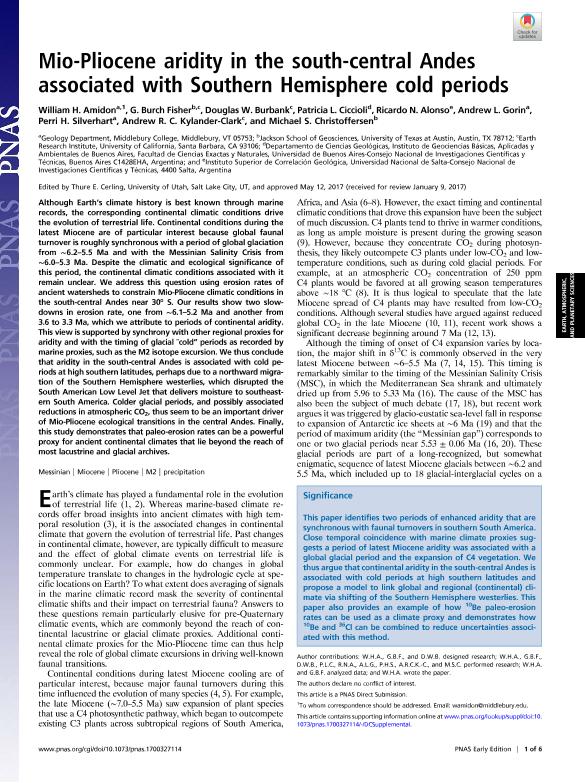Artículo
Mio-Pliocene aridity in the south-central Andes associated with Southern Hemisphere cold periods
Amidon, William H.; Fisher, G. Burch; Burbank, Douglas W.; Ciccioli, Patricia Lucia ; Alonso, Ricardo Narciso
; Alonso, Ricardo Narciso ; Gorin, Andrew L.; Silverhart, Perri H.; Kylander Clark, Andrew R.C.; Christoffersen, Michael S.
; Gorin, Andrew L.; Silverhart, Perri H.; Kylander Clark, Andrew R.C.; Christoffersen, Michael S.
 ; Alonso, Ricardo Narciso
; Alonso, Ricardo Narciso ; Gorin, Andrew L.; Silverhart, Perri H.; Kylander Clark, Andrew R.C.; Christoffersen, Michael S.
; Gorin, Andrew L.; Silverhart, Perri H.; Kylander Clark, Andrew R.C.; Christoffersen, Michael S.
Fecha de publicación:
06/2017
Editorial:
National Academy of Sciences
Revista:
Proceedings of the National Academy of Sciences of The United States of America
ISSN:
0027-8424
Idioma:
Inglés
Tipo de recurso:
Artículo publicado
Clasificación temática:
Resumen
Although Earth's climate history is best known through marine records, the corresponding continental climatic conditions drive the evolution of terrestrial life. Continental conditions during the latest Miocene are of particular interest because global faunal turnover is roughly synchronous with a period of global glaciation from 6.2-5.5 Ma and with the Messinian Salinity Crisis from 6.0-5.3 Ma. Despite the climatic and ecological significance of this period, the continental climatic conditions associated with it remain unclear. We address this question using erosion rates of ancient watersheds to constrain Mio-Pliocene climatic conditions in the south-central Andes near 30° S. Our results show two slowdowns in erosion rate, one from 6.1-5.2 Ma and another from 3.6 to 3.3 Ma, which we attribute to periods of continental aridity. This view is supported by synchrony with other regional proxies for aridity and with the timing of glacial "cold" periods as recorded by marine proxies, such as the M2 isotope excursion. We thus conclude that aridity in the south-central Andes is associated with cold periods at high southern latitudes, perhaps due to a northward migration of the Southern Hemisphere westerlies, which disrupted the South American Low Level Jet that delivers moisture to southeastern South America. Colder glacial periods, and possibly associated reductions in atmospheric CO2, thus seem to be an important driver of Mio-Pliocene ecological transitions in the central Andes. Finally, this study demonstrates that paleo-erosion rates can be a powerful proxy for ancient continental climates that lie beyond the reach of most lacustrine and glacial archives.
Palabras clave:
M2
,
Messinian
,
Miocene
,
Pliocene
,
Precipitation
Archivos asociados
Licencia
Identificadores
Colecciones
Articulos(IGEBA)
Articulos de INSTITUTO DE GEOCIENCIAS BASICAS, APLICADAS Y AMBIENTALES DE BS. AS
Articulos de INSTITUTO DE GEOCIENCIAS BASICAS, APLICADAS Y AMBIENTALES DE BS. AS
Citación
Amidon, William H.; Fisher, G. Burch; Burbank, Douglas W.; Ciccioli, Patricia Lucia; Alonso, Ricardo Narciso; et al.; Mio-Pliocene aridity in the south-central Andes associated with Southern Hemisphere cold periods; National Academy of Sciences; Proceedings of the National Academy of Sciences of The United States of America; 114; 25; 6-2017; 6475-6479
Compartir
Altmétricas



